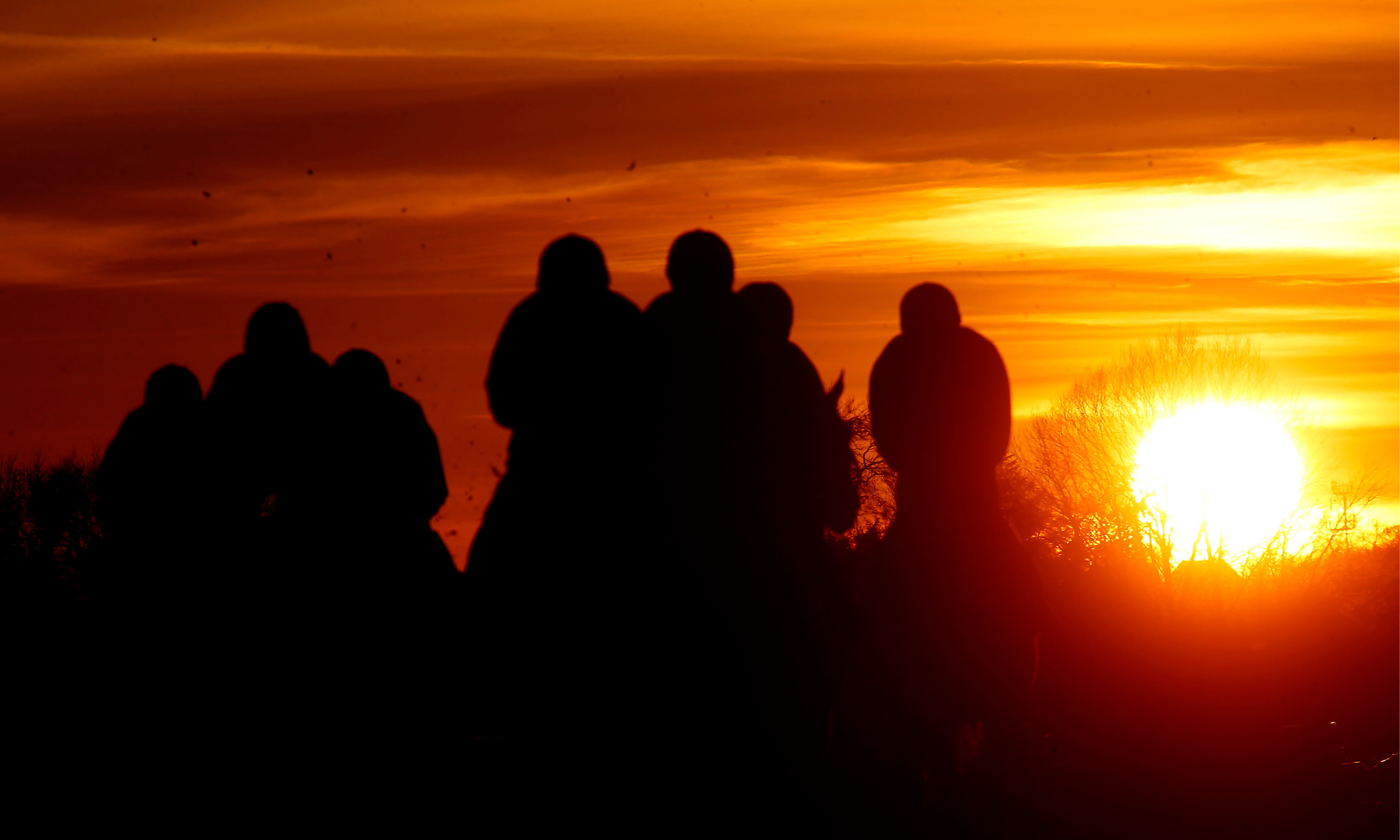
- Increased Levy funding for prize money set to flow from 1 Jan 2018, primarily targeting participants operating at mid and lower tiers of the sport
- c. £160m total prize money forecast for 2018 as racecourses also increase contributions
- New appearance money scheme rewards trainers and owners for running in races at Classes 3 to 5 (Jumps) and 4 to 6 (Flat)
- Most races to be run for minimum of £6,000 in 2018, resulting in substantial boost for owners, trainers, jockeys and stable staff
Additional prize money from the Levy and racecourses is set to flow to the sport’s participants from 1 January 2018. Those participants who operate at the mid and lower tiers of the sport are set to benefit most through an appearance money scheme and race incentive fund aimed at the sport’s grassroots participants.
The use of the additional Levy funds to support the lower and middle tiers was agreed as part of a three-year package by the sport’s tripartite governance structure comprising the British Horseracing Authority (BHA), Racecourse Association (RCA) and members of the Horsemen’s Group (HG).
There is also further positive news for British racing as the BHA has today confirmed that the total prize money forecast for 2018 sits at £160m. This represents a rise of at least £17m on the £143m which is forecast to be reached in 2017, and an all-time high in terms of returns to owners and competitors.
The rise in prize money can be attributed to two main sources – a previously announced £8m central Levy funding boost for grassroots racing through a new appearance money scheme and race incentive fund, and increased contributions by racecourses which are forecast to rise from around £75m in 2017 to £84m in 2018.
The sport’s new appearance money scheme also becomes active from 1 January. This scheme sees qualifying races introducing payments of at least £300 on the Flat and £350 over Jumps for horses finishing between fifth and eighth place. As well as improving the return to owners at the middle and lower tiers, the appearance money scheme has been designed to increase the number of races attracting at least eight runners with a view to encouraging betting on British racing.
Racecourses have the opportunity to unlock the extra prize money funding by investing their own revenues into the prize money and reaching minimum threshold values. This package of measures is designed to create a ‘virtuous circle’ for the sport, whereby greater investment in prize money should translate to more incentive for owners to put horses into training, which means a better racing and betting product owing to more competitive racing, encouraging greater engagement with the sport and therefore stimulating further financial growth.
As a result of the significant investment into grassroots prize money, a large proportion of races run in Britain in 2018 will have an advertised total race value of at least £6,000. Initial analysis of programme book 1 in 2018 shows that average prize money for races at Class 3 and below has risen considerably:
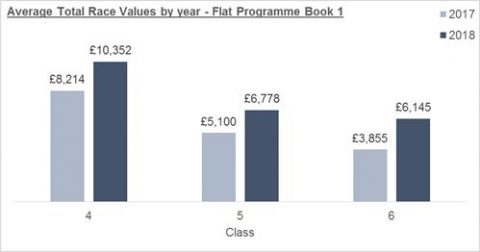
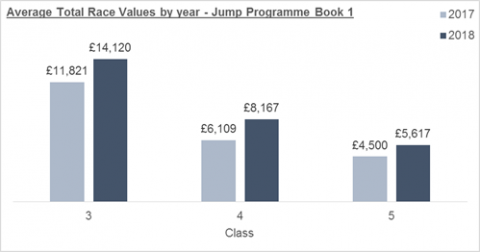
In addition, an existing £6m race incentive fund will continue to incentivise the programming and positioning of races at Class 1 to 3.
Nick Rust, Chief Executive of the BHA, said:
“It is very important for all those involved in our sport that we are due to see such significant prize money increases in 2018.
“Although there has been a gradual recovery in total prize money in recent years driven by increased investment from racecourses, the returns to our sport’s owners and participants have not been sufficient, in particular to those who are not competing at the top echelons. The support we received from the Government and, indeed, all political parties in establishing the new Levy has been crucial and means that we can target support towards those operating at the racing’s grassroots.
“The increased prize money on offer in 2018 does not resolve the sport’s prize money situation outright, but it is a step in the right direction. We hope that this good news will serve as an incentive to racehorse owners who are thinking of putting horses in training, and provide a timely boost to jockeys, trainers and stable staff, who rely in part on prize money for their livelihoods.”
Charlie Liverton, Chief Executive of the Racehorse Owners Association (ROA), said:
“The findings of the National Racehorse Owners Survey showed how costs and prize money were the primary reasons for owners to either lapse their involvement or not invest further in to the sport. The new Appearance Money Scheme therefore, should go some way to help alleviate those costs and reward owners whose horses race at the grassroots level. This is a positive start, however, there must be a continued effort from all in the industry to focus on securing more prize money at these lower levels for the benefit of all horsemen.”
Rupert Arnold, Chief Executive of the National Trainers Federation (NTF), said:
“This significant increase in prize money in 2018 is a major boost to trainers. We welcome especially the injection on funds into the grassroots of racing as it is at that level that so many horsemen are finding it hard to sustain a livelihood. We hope it helps to encourage more owners into the sport and therefore the number of horses in trainers’ yards.”
Dale Gibson, Executive Director (Racing) for the Professional Jockeys Association (PJA), said:
“We welcome the forthcoming prize money increases targeting grassroots and mid-tier racing in 2018. With an increased fixture list and therefore workload for horsemen and women next year, particularly for those at the sharp end, the additional funding injection is vital to everyone who derives their living from the sport. However, there remains more to be achieved in the longer term given the demands the fixture list is placing on Jockeys, stable staff and trainers.”
Stephen Atkin, Chief Executive of the RCA, said:
“The additional revenue generated by the new Levy funds will provide a significant boost to the sport through increased prize money. The forecast growth in prize money would not be possible without racecourses increasing their executive contributions to record levels so credit must go to them and we hope this investment will benefit the sport.”
Notes to editors:
- Total prize money figures since 2010:Year Prize money
2010 £ 99,100,137
2011 £ 94,060,430
2012 £ 97,940,859
2013 £ 114,415,135
2014 £ 123,180,347
2015 £ 132,367,742
2016 £ 137,853,890
2017 (forecast) £ 143,000,000
2018
(forecast) £ 160,000,000
- The total race values across the included race classes are as follows.Flat
Class 2 and 3 races have been included for completion purposes only to show minimum values. These races are not part of the new schemes and not eligible for incentive payments or appearance money.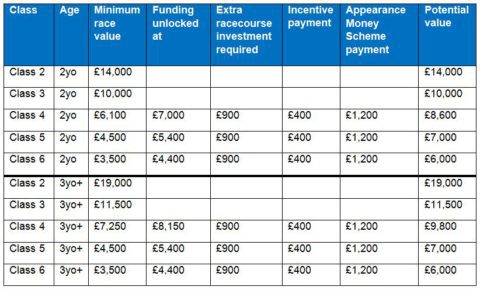 Jump
Jump
Class 2 races have been included for completion purposes only to show minimum values. These races are not part of the new schemes and not eligible for incentive payments or appearance money.
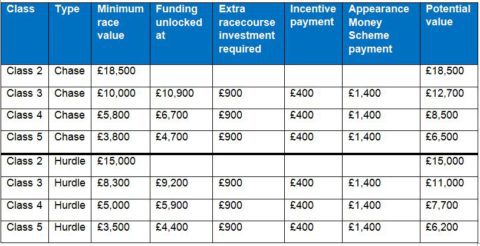
Note: For both Flat and Jump, maiden and novice races are excluded from the appearance money scheme but qualify for the additional prize money grant, barring Juvenile Hurdle races and Novice Chases which still qualify for both.By way of example, in order to trigger the appearance money and race incentive fund grants, which are active for races of Class 4-6 on the Flat and Class 3-5 over Jumps, racecourses need to invest £900 above the existing minimum race values.This would then lead to £1,600 of grant funding for each race, comprised of a £400 payment for extra prize money and around £1,200 in appearance money (sometimes more) which would be paid to horses finishing between fifth and eighth place in each race. Horses crossing the line in at least eighth place can expect to receive no less than £300 (Flat) and £350 (Jump) whether in appearance money or as prize money. Higher appearance money payments of up to £450 per placed horse are offered on Friday and Saturday evenings, as well as for Sundays.
Class 6 Jump races (i.e. largely NH Flat races) are not targeted and therefore can be staged for £3,500.
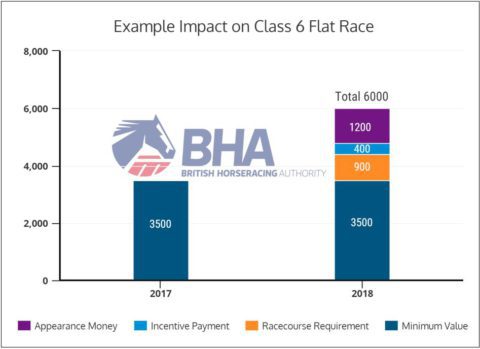
3. The minimum value of National Hunt Flat races will be increased to £3,500 from the existing value of £2,400.
